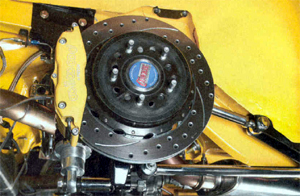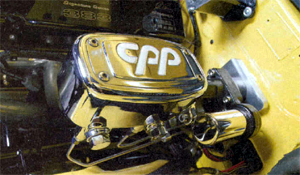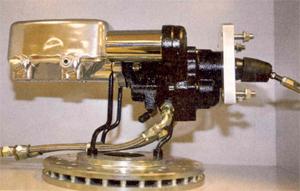|
|
 |
| Classic Performance Products |
| Builds The Ultimate 1970 Chevy Nova -
Part Five |
| Dem's Da Brakes Part One |
| writer: Mike Harrington |
| Courtesy of Super Chevy Magazine |
|
|
- The last few issues of SUPER CHEVY have followed the
build and performance of this Yellow '70 Nova owned by Jim Ries of Classic
Performance Parts (CPP). His Nova received new underpinnings from TCI,
and part of those underpinnings included a new set of Wilwood brakes. We
then tested the Nova in Fontana at the California Speedway. When it came
to the braking aspect of the tests, this little Nova stopped the shortest
distance of all the cars we've previously tested. That got us to thinking
about brakes and brake systerms. Does this Nova have some secret weapon
that the rest of us are unaware of ? Not likely. The truth is there are
several different answers to this question, from the master cylinder, to
power assist Hydraulic Brake Assist System to fluid, to calipers, to rotors,
to tires, to vehicle weight, and even to wheel size. In a quest to
dissect the Nova's braking system and check on its performance, it became
necessary to go back to Braking 101 and explore the anatomy of the more
common brake systems in use today by most Bow Tie enthusiasts. Brake systems
convert kinetic energy or the vehicle's movement into thermal energy or
heat. Thermal energy is a direct result of the friction from pad to rotor.
The more thermal energy created and dissipated from the braking system,
the faster the vehicle slows down. More on this later first, let's take
a look at the particular hardware installed on this '70 Nova and then dive
deeper into brake systems and their technology. Now that we know what's
in the Nova, we can breathe easy for a few minutes and look at the history
of braking and all the individual components that make up a vehicle's brake
system. Since the first production vehicles in the 1800s, automobiles have
always had the need for brakes. Horsepower alone means nothing if one can't
stop the horses. Even the earliest vehicles employed one type of braking
system or another, and these were all mechanical brakes. It wasn't until
1918 that hydraulic brakes were introduced to the automotive buyer. Those
first hydraulic or "juice brakes" were available on the 1918
Duesenberg. After 1918, most of the higher-end production vehicles were
equipped with hydraulic braking systems. In the 1930s, juice brakes became
commonplace on lower priced production vehicles, though Ford stuck with
mechanical brakes long after others because Henry was afraid of hydraulic
systems.
|
- Nearly all vehicles at the time were using drums for
their braking systems. It wasn't until the 1950s, when Chrysler introduced
disc brakes to its production vehicles, that disc brakes became an option.
Interestingly enough, in the early 1960s Studebaker perfected the use of
power boosted disc brakes, and from there it caught on until nearly every
automaker offered them as standard or option- al equipment. The Corvette
broke new ground for an American car company in 1965 with four-wheel disc
brakes became standard equipment (manual, with power assist optional).
With the modern technology available, the average musclecar enthusiast
can easily build a streetable 600 (or more) horsepower engine. Just as
engine building technology has progressed, so has brake technology. While
the initial designs and theories have remained mostly the same, the materials
and their applications have catapulted forward as well. The purpose of
this article is to focus mainly on disc brakes from GM OEM styles to performance
upgrades such as we see on this Nova. Due to the amount of information
we have thus far collected, we will have to break the story in half for
lack of space.
-
- BRAKE FLUID
- Brake fluid is the unsung hero of our systems. Brake
fluid is just about as entertaining and exciting as valvestems, yet without
it we would need to have Hercules sized legs in order to stop our cars.
Brake fluid's primary job is to transmit force from the master cylinder
to the calipers, and it does so under some intense pressures and temperatures.
This fluid is important enough that the government has regulated and set
a minimal standard with 14 properties that are required of every fluid
on the market. If the fluid fails to meet even one of the 14 set standards,
it will not receive a government DOT rating and cannot be sold as brake
fluid. The Department of Transportation National Highway Safety Administration
in Federal Motor Vehicle Safety Standard 116 (FMVSS116) has classified
brake fluids into three categories: DOT 3, DOT 4, DOT 5, and now DOT 5.1.
If water boils at 212 degrees Fahrenheit and freezes at 32 degrees, brake
fluid must function below and above any of the temperatures that will freeze
or boil water. In other words, brake fluid must remain viscous and resistant
to severe conditions.
|
- It must also absorb water without having an affinity
for doing so. Its boiling point and chemical properties must remain stable.
That's a lot to ask of a fluid, isn't it? It seems logical that if DOT
3 is good enough, then DOT 4 must be better. And if DOT 4 is better, then
DOT 5 and 5.1 must be better still. OK then, why? It all boils down to
boiling point. When brake fluid begins to boil (from the heat that's generated
in the system during braking), it forms gas bubbles. As these bubbles collect
and grow, they form pockets of gas in the brake lines. And since gas compresses
much easier than fluid, these gas pockets cause the pedal to compress or
become spongy. (This usually occurs during lots of hard braking, such as
coming down a mountain or on a road course.) This is what is known as brake
fade. Each respective class of fluid must meet a minimal wet and dry boiling
point. The term "wet" brake fluid means it's saturated with water,
while "dry" brake fluid means it's still pure and has no water
absorption yet. By the very nature and chemical makeup of brake fluid,
it will absorb water no . matter what climate it's in. The different DOT
spec fluids have chemical or formulation differences, as well as boiling
point differences. There are (at this point) three commercial formulations
for brake fluids; two are glycol based, and the third is silicone-based.
Silicone based fluids absorb no water and should never be mixed with glycol
ether based fluids. DOT 3 brake fluids are a mixture of polyalkylene glycol
ether and other glycols (all start life as ethylene glycol antifreeze);
DOT 4 fluids add borate esters to raise the boiling point. DOT 5 is silicone
oil based with additives. DOT 5.1 fluids have essentially the same chemical
makeup as DOT 4, only they have as high a boiling point as DOT 5, which
is silicone based. DOT 3, 4, and 5.1 can be safely mixed and used together
because they're made of the same compounds, while a DOT 5 mixture should
never be mixed with the others due to its silicone makeup. When was the
last time you remember changing the brake fluid in your vehicle? The average
enthusiast should change his fluid every 1-2 years just to keep the boiling
point up.
|
| |
Dry Boiling Point Fahrenheit |
Wet Boiling Point Fahrenheit |
Composition |
| DOT 3 |
401 |
284 |
GLYCOL ETHER |
| DOT 4 |
446 |
311 |
GLYCOL ETHER/BORATE ESTER |
| DOT 5 |
509 |
356 |
SILICONE |
| DOT 5.1 |
509 |
356 |
GLYCOL ETHER/BORATE ESTER |
|
 |
Grabbing power in the front of this Nova is performed
by fixed Wilwood six-piston calipers with Wilwood brake pads and 13-inch
two-piece rotors. |
 |
The rear of the vehicle is equipped with fixed Wilwood
four-piston calipers and 13-inch rotors as well. |
 |
Power from the pedal to the calipers is done with CPP's rather
new production MCPV1 Hydraulic Brake Assist System master cylinder. We'll
take a deeper look at this later. |
 |
Here is another shot of the CPP Hydraulic Brake Assist System
taken in its showroom. What's unique about it is the location of the hydraulic
unit. Instead of being located on the right side, where it could interfere
with the valve covers, it's located on the left side. This leaves room for
taller valve covers. |
SILICONE BASE BRAKE FLUID (SBBF)
The U.S. DOT defines silicone brake fluid as that which
consists of no less 1than 70 percent of adiorgano polysiloxane by weight.
Silicone based fluids are regarded as DOT 5 fluids. They are highly compressible
and can give the driver the feeling of a spongy pedal. The higher the brake
system temtperature, the more the compressibility of the fluid increasing
the feeling of a spongy pedal. Silicone-based fluids are non-hydroscopic,
meaning they will not absorb or mix with water. When water is present in
the brake system, it will create a water/fluid/water/fluid situation. Because
water boils at approximately 212 degrees Fahrenheit, the ability of the
brake system to operate correctly decreas is important to remember that
water may be present in any brake system. Therefore, silicone brake fluid
lacks the ability to deal with moisture and will dramatically decrease a
brake system's performance. |
BRAKE PADS
Every vehicle owner wants brake pads that are quiet yet grab like an eagle's
talon and leave very low dust. Good luck on that, as with all things automotive
there is a compromise. Brake pads are the sacrificial lamb in the brake
system. They will all wear down and reach the point of no return and eventually
need replacing. Brake pads are like Coke and Pepsi, Both have similar ingredients,
yet each company mixes their various ingredients differently, and each company
has their secret mix that the other guy may not have. Yet both can be classified
as a cola. Just like Coke or Pepsi, each brake pad manufacturer keeps their
specific pad compound a secret. Surprisingly, the government regulations
and definitions that apply to brake fluids and their chemical makeup don't
apply to brake pad manufacturers. Nearly all brake pads contain similar
types of etc. Brake pad compounds can be a very deep and broad subject.
Rather: than speculate about the chemical makeup of brake pads and their
performance, we went straight to the source and asked the professionals
at Hawk Performance to define and explain the difference in pads in layman's
terms. |
ORGANIC PADS?
Organic brake pads are defined as friction materials
with less than 20 percent metallic content. Historically, most organic brake
pads contained asbestos, which is now classifisd as a hazardous material.
Today, the organic pads used in the United States are identified as NAOs
(Non-Asbestos Organics).
ADVANTAGES OF NAO
LOW DUST OUTPUT
MINIMAL NVH (NOISE, VIBRATION AND HARSHNESS)
LOW ROTOR WEAR
DISADVANTAGES OF NAO
LOW COEFFICIENT OF FRICTION (STOPPING POWER)
POOR RESISTANCE TO ELEVATED TEMPERATURES (OVER 450 F).
CAUSING BRAKE FADE
HIGH BRAKE PAD WEAR RATE |
WHAT ARE SEMI-METALLIC PADS?
Semi-metallic brake pads are defined as friction
materials with more than 20 percent metallic content, but with less than
75 percent metallic content. Because the
definition is so broad, some companies have adopted the terms "low
met" and "high met" to indicate at what end of the spectrum
their product could be categorized. Semi-metallic friction materials are
the most widely used technology for automotive disc brake pads.
ADVANTAGES OF SEMI-METS
MEDIUM TO HIGH COEFFICIENT OF FRICTION
EXCELLENT RESISTANCE BRAKE FADE AT LOW TO HIGH TEMPERATURES
(1,000 F)
VERY GOOD PAD WEAR
DISADVANTAGES OF SEMI-METS
SLIGHTLY HIGHER DUST OUT PUT THAN ORGANICS
MINIMAL NOISE OUTPUT BUT GREATER RISK OF NVH ISSUES WITH
POORLY ENGINEERED FORMULATIONS
GOOD ROTOR WEAR BUT SLIGHTLY GREATER THAN NAOS |
WHAT ARE CERAMIC PADS?
WHY THE BUZZ OVER CERAMIC?
Contrary to popular belief and current marketing
strategies, ceramic brake pads and rotors are not available in the general
automotive market. A true ceramic brake pad is just that, a ceramic composite
material that is designed to run against itself. The latest market trend
toward ceramic brake pad technology is 90 percent marketing and 10 percent
fact, according to Hawk. The reaity is that the market defines ceramic brake
pads as friction material with more than 1 percent ceramic content. Considering
that ceramic materials have been used in organic, NAO, and semi-metallic
formulations for decades, the marketers simply repacked and relabeled existing
technology. |
It should be noted that several friction manufacturers
have developed NAO and semi-met formulations with a higher than normal concentration
of ceramic materials. Typically the ceramic element still remains under
15 percent of the overall friction formulation content. What is important
to understand is the marketing promise of a "ceramic" brake pad
and fulfilling that promise with a NAO or semi-met product that has a minimum
of 1 percent ceramic content. Note: The ceramic brake promise takes the
best features of both the semi-met and NAO characteristics and rolls it
into one product technology. This is not by accident.
THE CERAMIC BRAKE PAD PROMISE
LOW NOISE OUTPUT
MINIMAL NVH ISSUES
LOW DUST OUTPUT
MEDIUM COEFFICIENT OF FRICTION
STABLE COEFFICIENT OF FRICTION OVER A BROAD TEMPERATURE
RANGE
GOOD ROTOR WEAR |
WHAT TYPE OF BRAKE PAD WOULD HAWK RECOMMEND TO THE AVERAGE
ENTHUSIAST WHO PLANS ON HIS CAR BEING STREET DRIVEN ONLY?
Hawk Performance offer three products for street vehicles,
HPS for passenger and performance street cars, LTS for light trucks and
SUVs, and
Performance Ceramic for select domestic and European import cars and trucks.
Yes, all three products have 1 percent or more ceramic content. What's more
important is that they all deliver the performance characteristics promised. |
WHAT TYPE OF PAD FOR THE GUY WHO DRIVES HIS VEHICLE
ON THE STREET THEN MIGHT TAKE IT FOR AN OCCASIONAL AUTOCROSS OR DRAG RACE?
Use race pads for the track and street pads for street.
Some companies offer autocross products that are safe to use when driving
from home to the track and back. It is still strongly recommend that consumers
change back to street pads after any race event. Some pads need a lot of
heat in them to work properly and are not suitable for the street. |
 |
|
|



